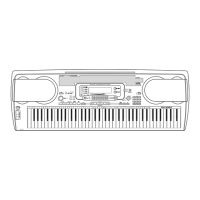— 18 —
2. AC adaptor detection check.
1 Press “TONE” button.
2
When the instrument detects that an AC adaptor is plugged in, an OK sound
sounds.
“ACJ OFF” appears and an NG sound sounds when the AC adaptor
is not plugged (when batteries are used).
3. Sustain jack check. (If no pedal, this check can be skipped)
1 Press “RHYTHM” button.
2 Press “Sustain pedal” .
3 Release “Sustain pedal” .
4 NG sound, “OFF” sound this case, must be audible.
4. Low Voltage detection check.
1 Press “DRAWBAR ORGAN” button.
2 OK sound must be audible.
5. MIDI IN/OUT check (If there is no MIDI cable, this check can be skipped)
1 Connect MIDI IN and MIDI OUT terminals with a MIDI cable.
2 Press “CH3” button.
3 Disconnect the MIDI cable.
6. Sound Source check
1 Press “7” button.
2 The MAX sin sound sounds from Left spesker.
3 Press “8” button.
4 The MAX sin sound sounds from Both spesker.
5 Press “9” button.
6 The MAX sin sound sounds from Right spesker.
7. ROM check
1 Press “INTRO/ENDING1” button.
8. Flash memory bus check
1 Press “INTRO/ENDING2” button.
9. DSP RAM check
1 Press “VARIATION/FILL-IN 2” button
10. CPU RAM check
1 Press “SYNCHRO/FILL-IN NEXT” button.
11. LED check
1 Press “TEMPO쑼” button.
2 LEDs illuminate in the following order.
a. MODULATION
b. FULL RANGE CHORD
c . FINGERED
d. CASIO CHORD
e. DATA ACCESS
f . DRAWBAR ORGAN
g. DSP
Message on LCD
4 ACJ ON
4 SUS CHK
4 SUS ON
4 US OFF
4 VOLT HI
4 TG MAX L
4 TG MAX C
4 TG MAX R
4 ROM CHK
앗
4 ROM OK
2 000
4 FMB CHK
앗
4 FMB OK
4 MIDI OK
4 DRAM OK
4 CRAM OK
4 LED CHK
앗
앗
앗
앗
앗
앗
앗
앗
4 LED END

